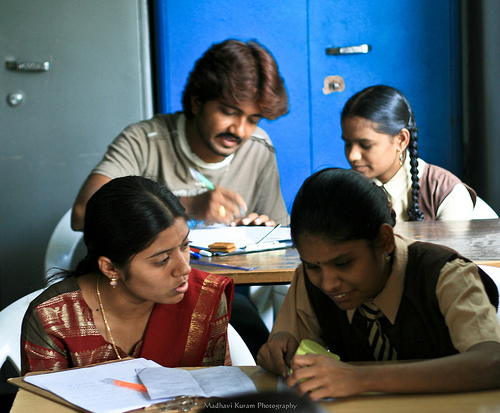For week three of the DFLP course we are asked to comment on a post from Leigh Blackall’s blog on the topic of flexible learning, providing supporting or counter arguments and supporting evidence. I have decided to comment on his posting Revisiting content is not king. Connectivity is priority KAREN . In this post Leigh suggests that, for learners, connecting with one another and establishing professional networks has primary importance over the delivery of course content. He suggests that a lot of content is ignored, and that learning occurs primarily through social interaction between course participants. Leigh goes on to present data which suggests that only 33% of New Zealand households have a broadband internet connection. Most people therefore do not have high speed internet access which may impact on their ability to connect through this medium.
Vgotsky theorised (thanks to Bronwyn for this link) that social interaction plays a fundamental role in cognitive development. He focussed on the connections between people and their socio-cultural context. When considering continuing professional development for health professionals, research has consistently found a preference for keeping up to date with current practice, through practice communities and professional networks. Communities of practice may be used for problem solving, sharing information, sharing resources, discussing developments as well as establishing where there is existing knowledge or gaps in knowledge and highlighting areas worthy of further investigation (Fahey & Monaghan, 2005; Gabbay & Le May, 2004; Lee, 2006; Tolson McAloon, Hotchkiss & Schofield, 2005; Wenger, 2006). I recently completed a course [Facilitating online learning communities ] where I explored the use of online tools to support the development of learning communities.
I agree that practice communities, and group interaction, play a large role in learning. I also believe that learning is life long. We need our students to learn the skills, and access resources, that will support their continuing learning and development after they have completed their course of study, and gained accreditation in their chosen profession. There is also a significant amount of course content that students need to access and interact with. In the traditional classroom setting this would be done through the delivery of lectures, in the new flexible model of course delivery, there is an opportunity to reconsider this, and look at other ways to guide students to this material and support their learning. George Siemens discusses the concept of curatorial teaching. He suggests that lecturers provide access to resources for students to peruse and learn from. Gilly Salmon developed a five stage model for e-moderation, which is an alternative to traditional teaching for the online environment. The e-moderator and the curator seem to share some aspects in common. Both encourage autonomy for the learner, while they also provide direction to resources that will support learning. Salmon’s model provides a framework for scaffolding learning, as students learn and develop more knowledge of their topic.
As the time is fast approaching when we will be delivering our midwifery course through a more flexible model, with much of the course delivered at a distance, these issues are taking on greater urgency for me. If community is an important component of learning, how can we support students, who are geographically distant from each other, to develop connections and a sense of community? I provide a rural midwifery locum service, and I am aware of the slow internet connections in places that I work. These locations and other similar locations, are where our students will be located. Kildea et al (2006) identified technical difficulties and communication problems amongst rural and remote rural midwives in Australia in relation to the provision of education resources. How can we overcome technical difficulties to support student communities and facilitate learning? I am not sure that these issues have been addressed. I am interested to see the KAREN project, which Leigh referred to, and which promises high speed internet access for universities and education institutions, but will this help midwifery students located in rural areas?
During the previous course I learned a great deal about web 2.0 and social networking tools. I am now familiar with tools such as RSS, blogs, wikis igoogle, del-ici-ous, YouTube, Flickr, Creative commons etc. These things have very quickly, over the last 6 months, become part of my life and make my online existence much easier and more satisfying. It has been a huge journey and has taken a lot of time to become reasonably comfortable and familiar with these tools. I am aware however that I am in a minority in the midwifery, and perhaps even the education, community. Just accessing email is enough for many. I do believe that it is of considerable importance that staff involved in flexible delivery are familiar and comfortable with the use of at least some of these tools, but I see no real commitment from individuals or programme managers to promote acquisition of these skills. When we embark on the flexible delivery of our midwifery course we will have enough to think about just getting to grips with the course without also having to gain new skills with web 2.0 tools. I have started a blog with a group of students I am working with this year. It is early yet but is not being used much at the moment.
How can we support the techno-challenged to become the techno-savy? Do we need to? Can a course of study be delivered in a flexible mode, with a proportion of distance learning and online components without familiarity with these tools? Only time will tell I think.

Image: Hip Hop Connected. Jayes fluid step1: From Scott Eric William’s photos at flickr.com
References
Gabbay, J., & Le-May, A. (2004). Evidence based guidelines or collectively constructed “mindlines”? Ethnographic study of knowledge management in primary care. British Medical Journal, 329, 1013-1017.
Gosling, A. S., Westbrook, J. L., & Spencer, R. (2004). Nurses use of online clinical evidence. Journal of Advanced Nursing,
Kildea, S., Barclay, L., & Brodie, P. (2006). Maternity care in the bush: using internet to provide educational resources to isolated practitioners [Electronic Version]. Rural and Remote Health. Retrieved 10th September 2006 fromhttp://rrh.deakin.edu.au.47(2), 201-211.
Lee, S. W.-Y. (2006). The interplay between self directed learning and social interactions: Collaborative knowledge building in online problem-based discussion. Paper presented at the 7th International conference on learning sciences. ICLS’06., Bloomington IN.
Tolson, D., McAloon, M., Hotchkiss, R., & Schofield, I. (2005). Progressing evidence-based practice: an effective nursing model? Journal of Advanced Nursing, 50(2), 124-133.
Wenger, E. (2006). Communities of practice, a brief introduction. Retrieved 29th December 2006, from http://www.ewenger.com/theory/index.htm

 Image:
Image:  delivery format. I have not been blogging much because I have been so busy working on this but I now need to record what I have been up to for the last few weeks. So to bring you up to speed on what this is all about here is a brief outline of the programme.
delivery format. I have not been blogging much because I have been so busy working on this but I now need to record what I have been up to for the last few weeks. So to bring you up to speed on what this is all about here is a brief outline of the programme.







